Industrial Robot Control Board
Details
The control board is equipped with a variety of features and components designed to ensure reliable and efficient control over the robot. One of the key elements is the microcontroller or processor, which acts as the brain of the system. It processes the incoming data, executes instructions, and generates the necessary signals to control the robot’s motors and actuators.

Motor drivers are another critical component of the control board. These drivers convert the low-level signals from the microcontroller into high-power signals required to drive the motors of the robot. The control board also incorporates various sensors to provide real-time feedback and information about the robot’s position, speed, and environmental conditions. This allows for precise control and ensures the robot can safely navigate its surroundings.
Communication interfaces are another important feature of the control board. These interfaces enable seamless communication between the control board and external devices such as computers, programmable logic controllers (PLCs), and human-machine interfaces (HMIs). This facilitates programming, remote monitoring, and data exchange, enhancing the overall flexibility and usability of the industrial robot.
The control board often includes safety features to protect the robot, its surroundings, and operators. These features can include emergency stop buttons, safety interlocks, and fault detection mechanisms. In the event of a malfunction or safety breach, the control board can quickly respond to ensure the robot comes to a halt and avoid any potential dangers.
In advanced control boards, additional features like real-time operating systems, motion planning algorithms, and artificial intelligence capabilities may be incorporated. These features enable more sophisticated and autonomous control over the robot, improving its efficiency, accuracy, and adaptability to complex tasks.
Overall, an Industrial Robot Control Board is a critical component that brings together all the necessary capabilities for controlling, coordinating, and monitoring the operation of industrial robots. By providing precise control, safety measures, and communication capabilities, it ensures optimal performance and productivity in industrial settings.
Advantages
1. Low-level The control platform aims to realize the basic functions, the performance indicators basically meet the requirements, and the scalability is poor; represented by Arduino and Raspberry PI, the peripheral interface realizes modular splicing, the amount of software code is reduced, and the basic function requirements can be met, which is high in quality and low in price .
2. The middle-level control platform uses DSP+FPGA or STM32F4 or F7 series as the core architecture to design the control platform. It can meet all the basic functions, and at the same time, there is a huge room for improvement in the realization of scalability, performance indicators, and control algorithms. Peripheral interface circuit design or modular splicing of some functions, the amount of software code is large, and it is completely independent.
3. The high-level control platform uses industrial computer as the core control system, and uses data acquisition cards to read and configure sensing data and drive information. Fully realize the modular splicing, only need to carry out software configuration, no core technology, high cost.










